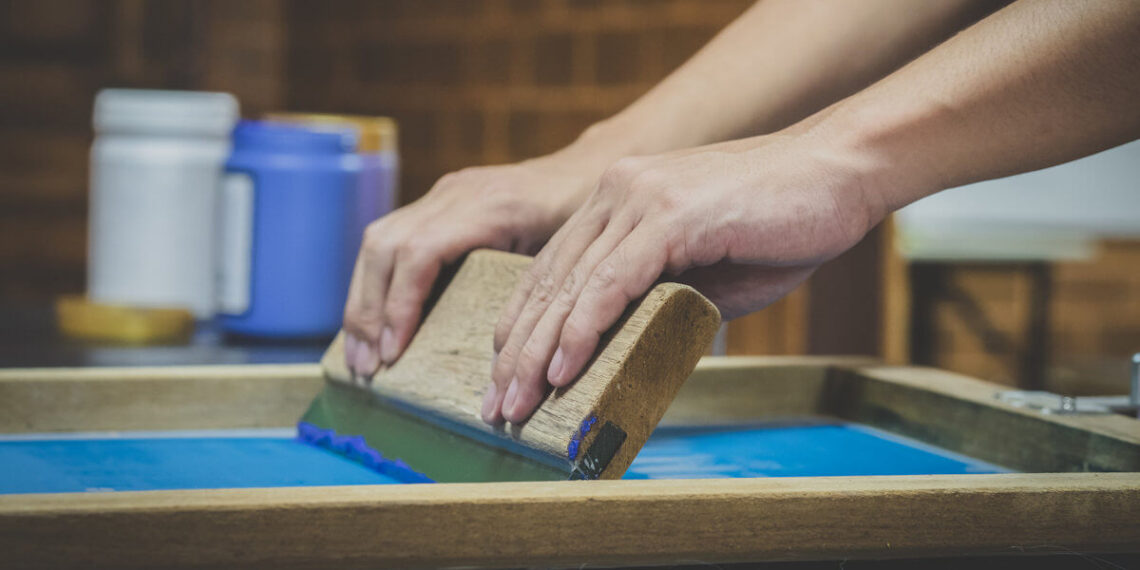Screenprinting is something that has been around for a too lengthy timespan. Individuals have been donning their logos, and what they or what their organization relies on all through time. What’s screenprinting, and what are the different sorts? There are many various sorts of printing for multiple types of norms and needs. Screenprinting, also alluded to as silk screening, is a fascinating procedure acclimated with applying pictures to materials imprinted on shirts, coats, and different kinds of attire or even banners signs.
The technique is considered fundamental and has developed altogether with the progression of innovation and gear. This printing strategy utilizes a woven cross-section that’s extended over an edge to help an ink-hindering stencil. The stenciled territory stays open, while the non-stenciled zone is brimming with a non-permeable material.
The open regions of lattice move ink or other printable materials, which might be squeezed through the cross-section as a sharp-edged picture onto a substrate. At that point, a squeegee is pulled across the cross-section to compel the ink through the open zone of the lattice onto the substrate, making the picture. This cycle is all-inclusive to all or any type of screenprinting, yet there are different kinds of screenprinting.
Look at them one by one – plastisol, which is frequently one among the principal normal assortments of ink utilized in screenprinting. It’s a plastic-based ink made for clothing. Although it’s largely less expensive, it’s the business standard, valuable for thick prints, and extremely popular. The delicate plastisol ink is laid straightforwardly onto the material, covering the shirt with a layer of the realistic.
Water-based inks will offer more entry of material than plastisol-based cycles, and are utilized when a gentler result is desired. This can be a better-quality ink made for delicate shirts extensively used in retail printing. Watch out when water-based inks keep going as long because the piece of clothing does. Release is, moreover, a water-based ink, yet it’s blended in with an activator, and is utilized for imprinting on hazier or hued articles of clothing. This ink helps the material tone while keeping the shade where print tone is noticeable.
Release inks just work on 100% cotton textures, and may even now be eccentric, relying on the treatment and color part of the material. Delicate hand screenprinting is perhaps the first mentioned sort of screenprinting these days, and is just reachable with water-based or release inks. The word hand alludes to how the print region feels. This sort of printing is well-known – vintage printing contains a delicate hand with a more troubled look. These days, individuals’ preferences for screenprinting are further developed and refined. They like articles of clothing that are gentler to the touch with a better-quality look and feel.
May it be plastisol print, gel, metallic, or foil, there are several different types of printing techniques for different kinds of people. You can be a corporation, a private brand, a nonprofit, or a school, but everything boils down to quality. The different wants can depend on different factors, such as wanting to be more efficient, stand out, or be more eco-friendly with something such as green printing. That’s right. Printing can be made from something such as a soybean or corn product, so you know that when you’re sporting your apparel, whatever is going down the drain is never harmful to the environment.
Consider also what kind of graphic you wish to sport and its size. There’s a way for everything; you just need the idea of where you want to go with your design, and how you genuinely want it to look. Keep in mind that just because most use plastisol inks doesn’t mean that’s what you’ll use, but in the process, you’ll never be alone or guessing. Not all fabrics and inks are created equal or similar. There are different tactics to have the design come out in the desired way. Thrive Screenprint makes it easy, and the experts are there to help. The design process can be incredibly stressful, but rest assured it’s in good hands when you hand the design over.
It’s essential to do research and go to the right people that will handle you with care, and help you get what you want without breaking the bank. There have been many times when someone handed over a design and paid a lot of money, and it didn’t end up looking as it was in mind. When doing research, there’s a pool of different resources, and it can be overwhelming since there are so many kinds of t-shirt printing.
The best thing to do is calm down and relax because, after the design and layout, you really don’t have to do much, especially if you’re into dropshipping. Present-day things are much easier, and much of the process is done for you. You must just sit back, wait, and look over the outcome to make sure it’s exactly what you want. It’s crucial to consider the different ink and style options before deciding, but the right decision will be made with the correct resources. It’s not all as hard as it sounds, and is quite easy after the project has been started. Like anything, it may worry you because this is important, but it will turn out perfectly after everything is done. You’re never alone in your design and thoughts. Naturally, you have to keep track of the process, but it’s quite quick and painless.

